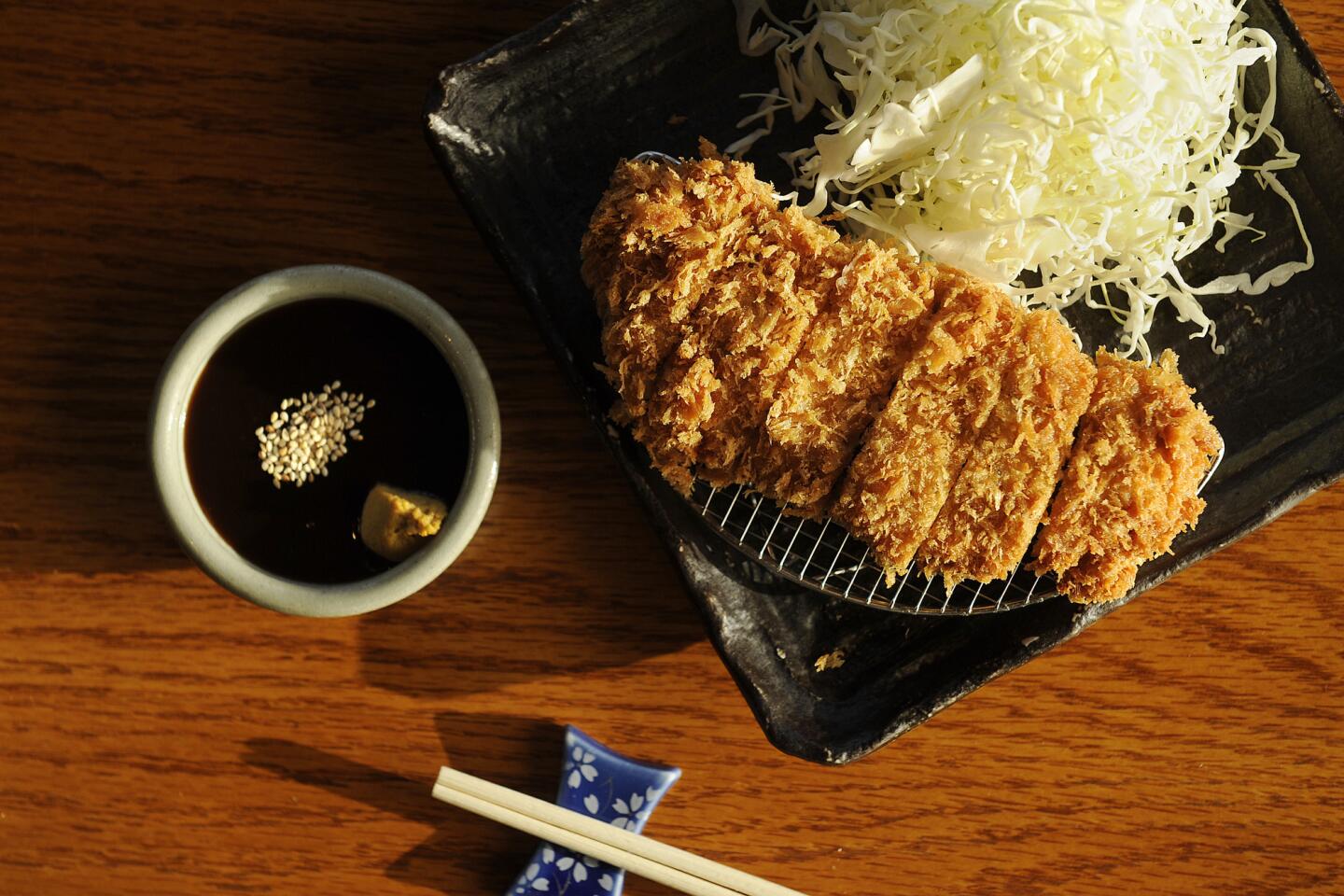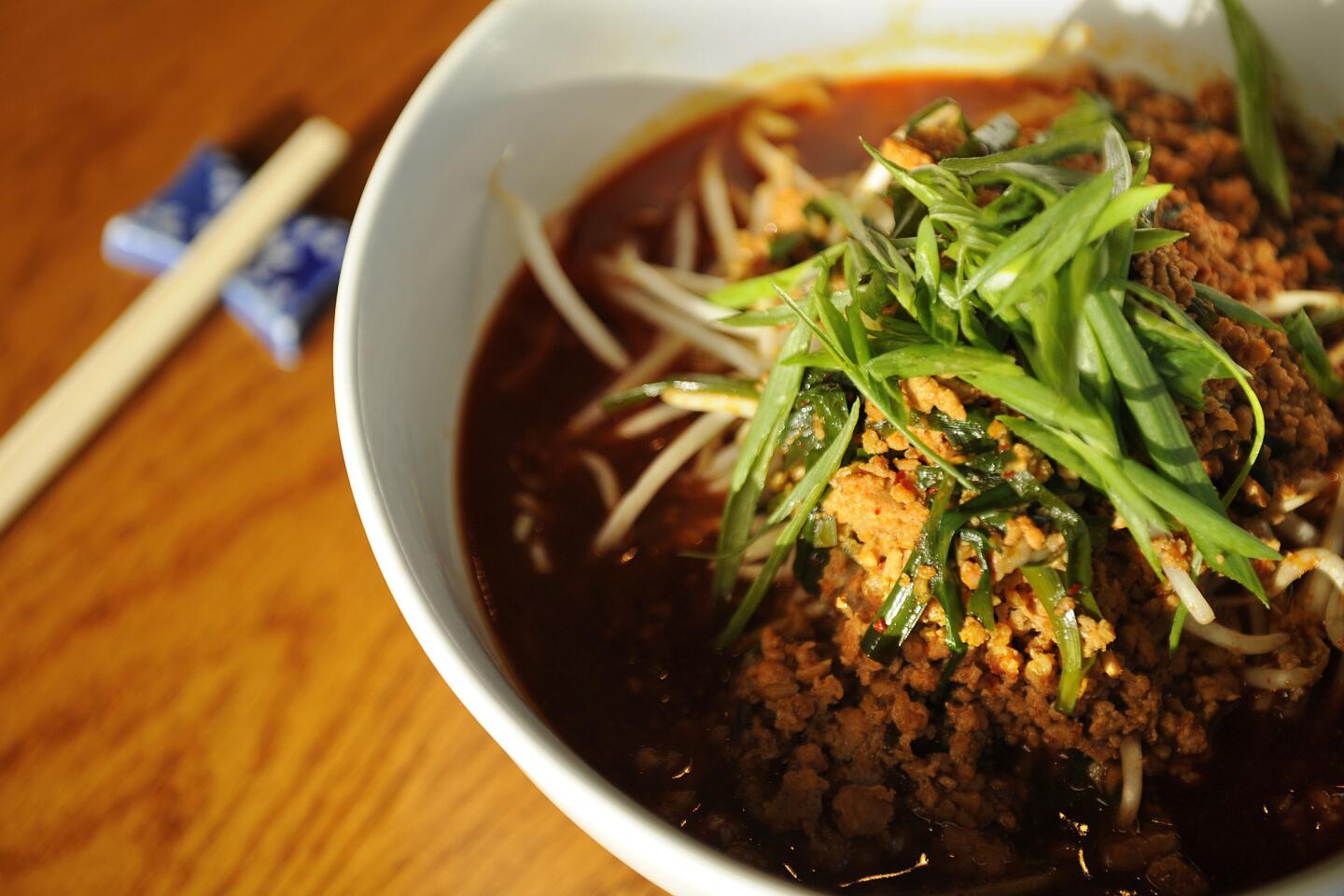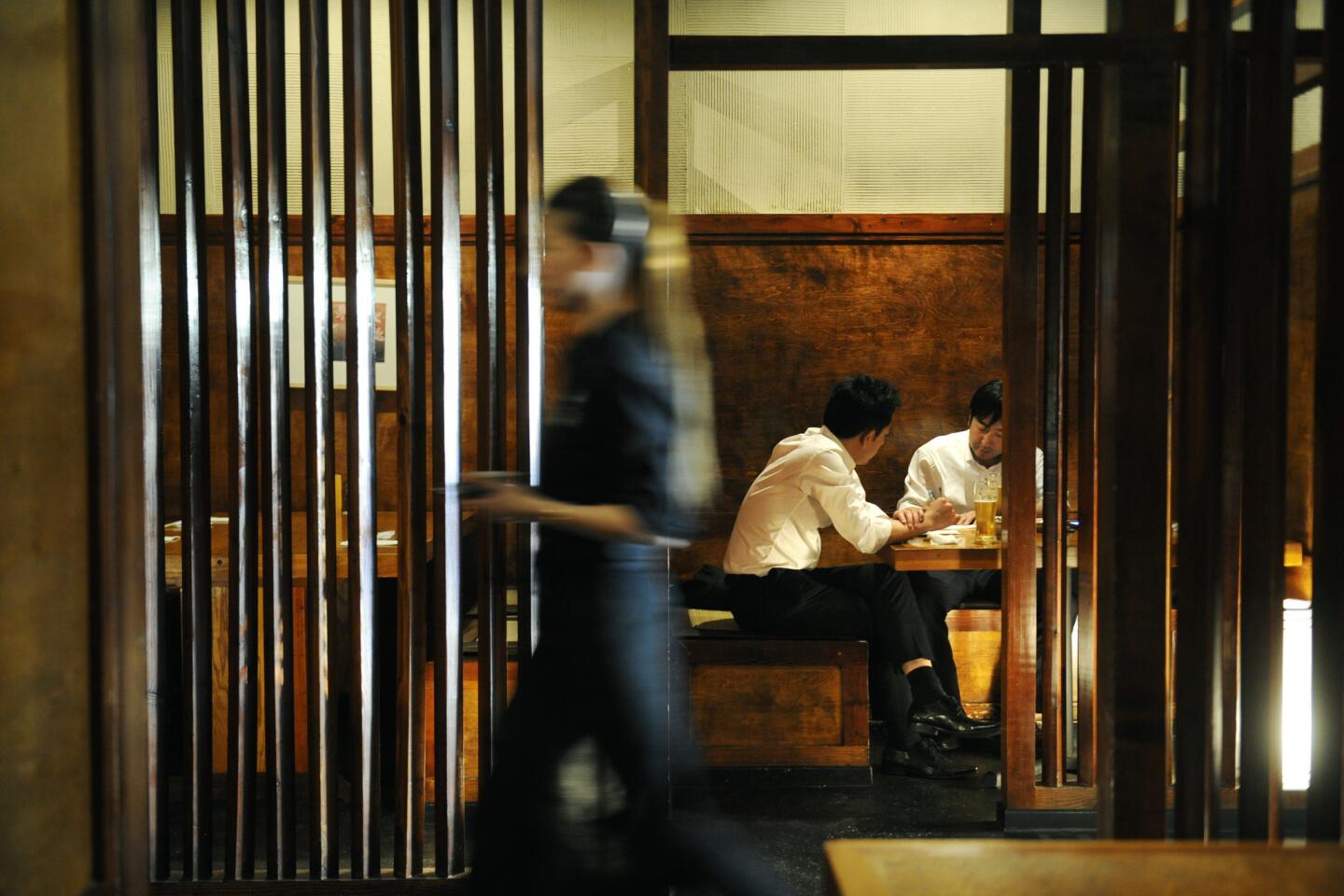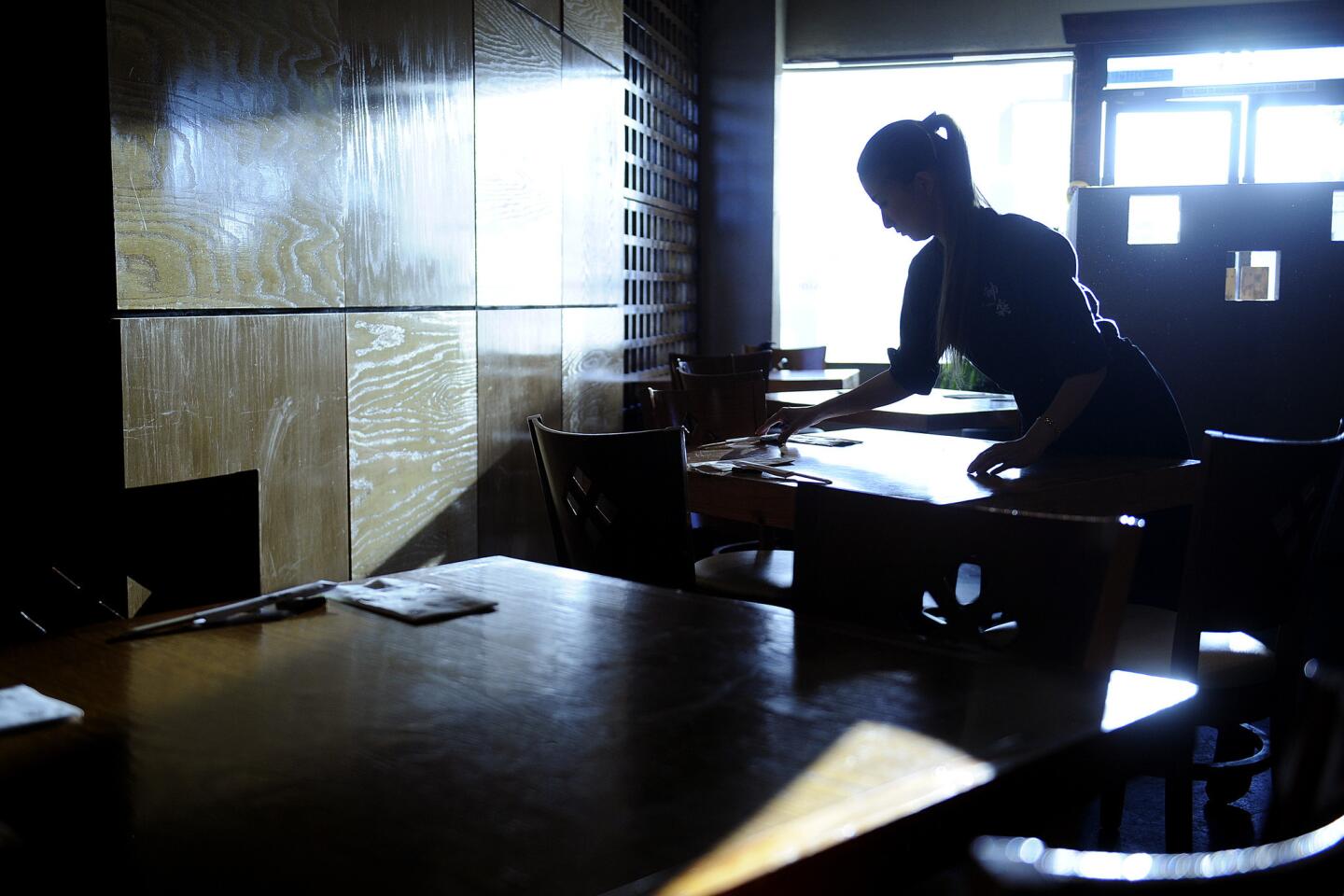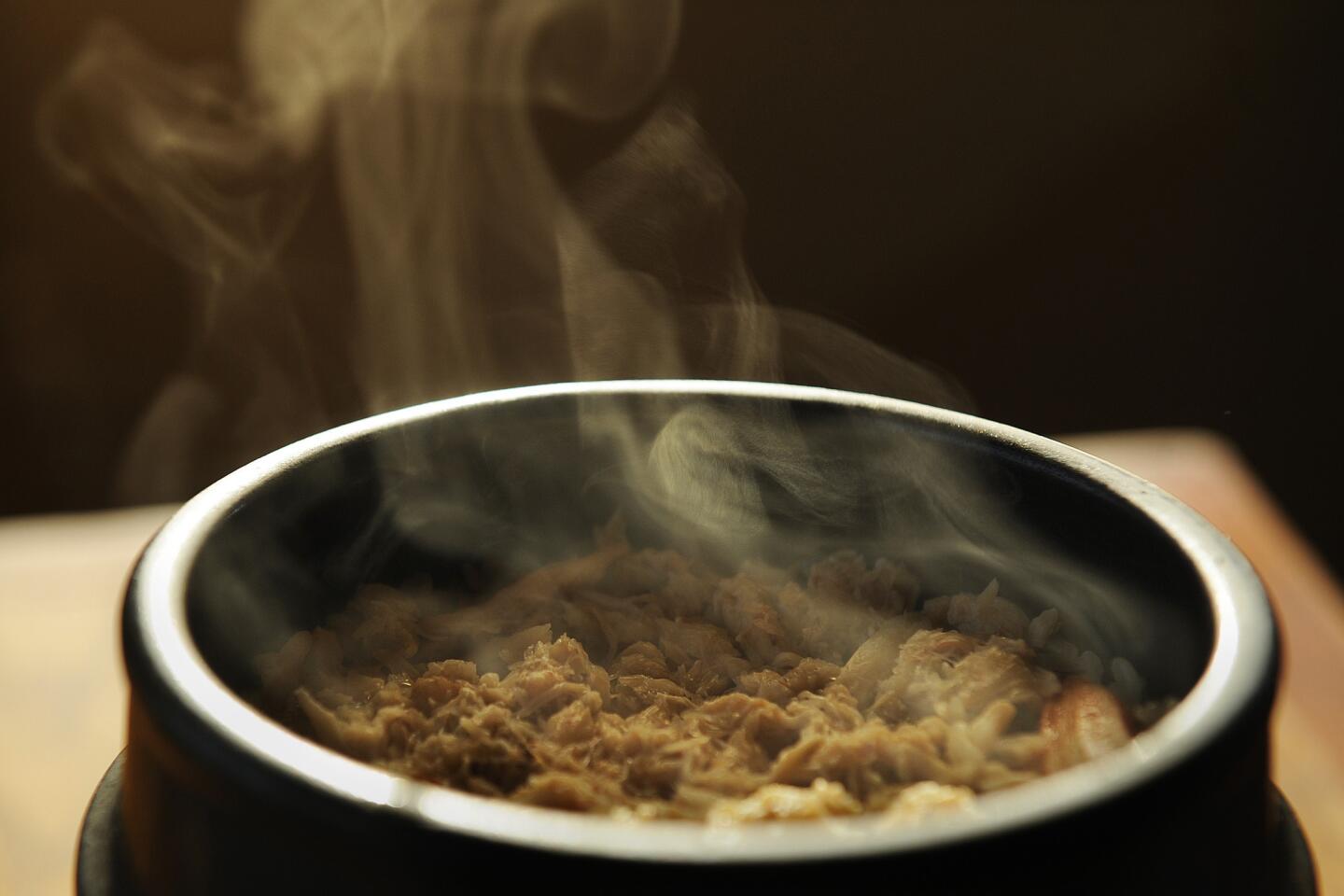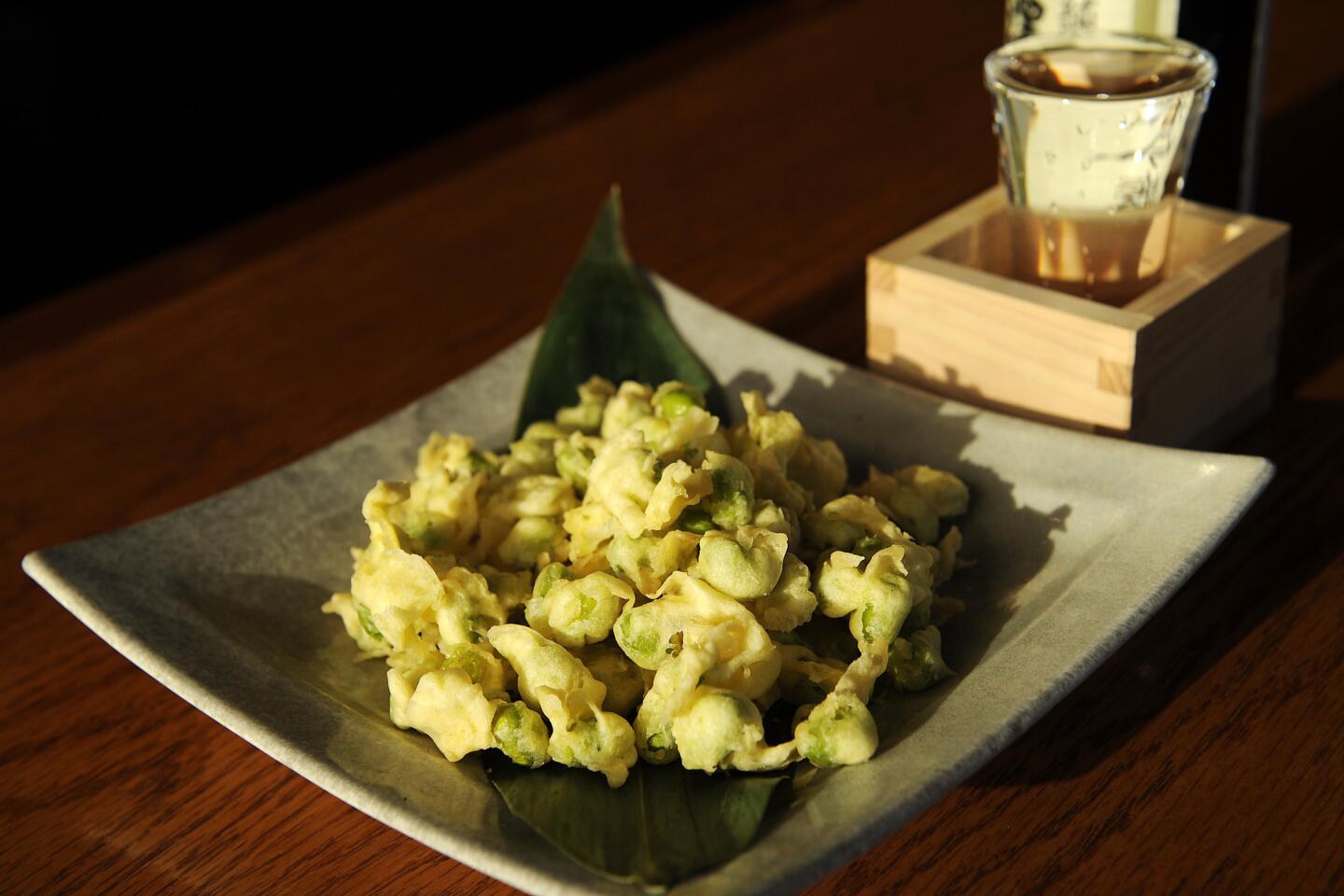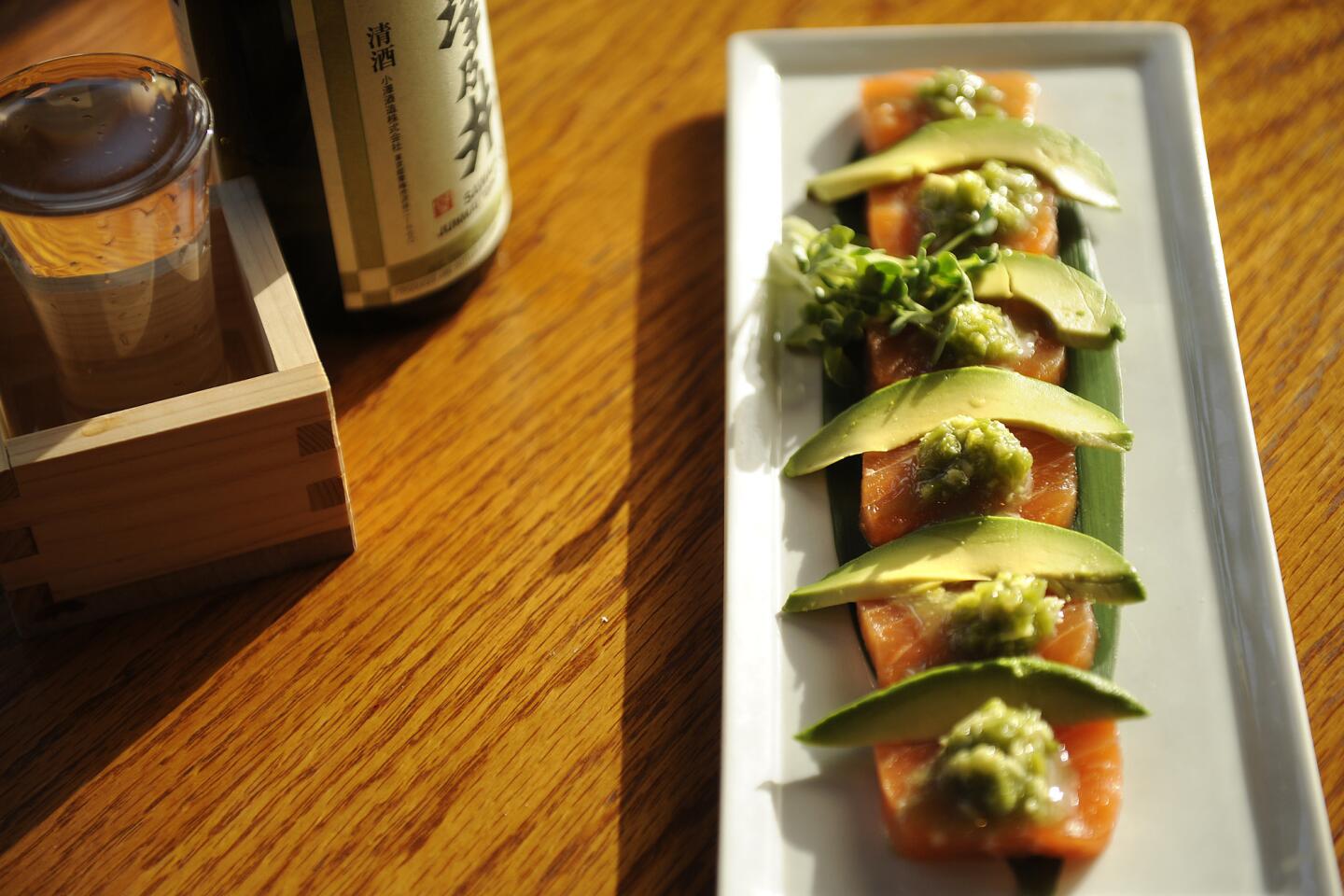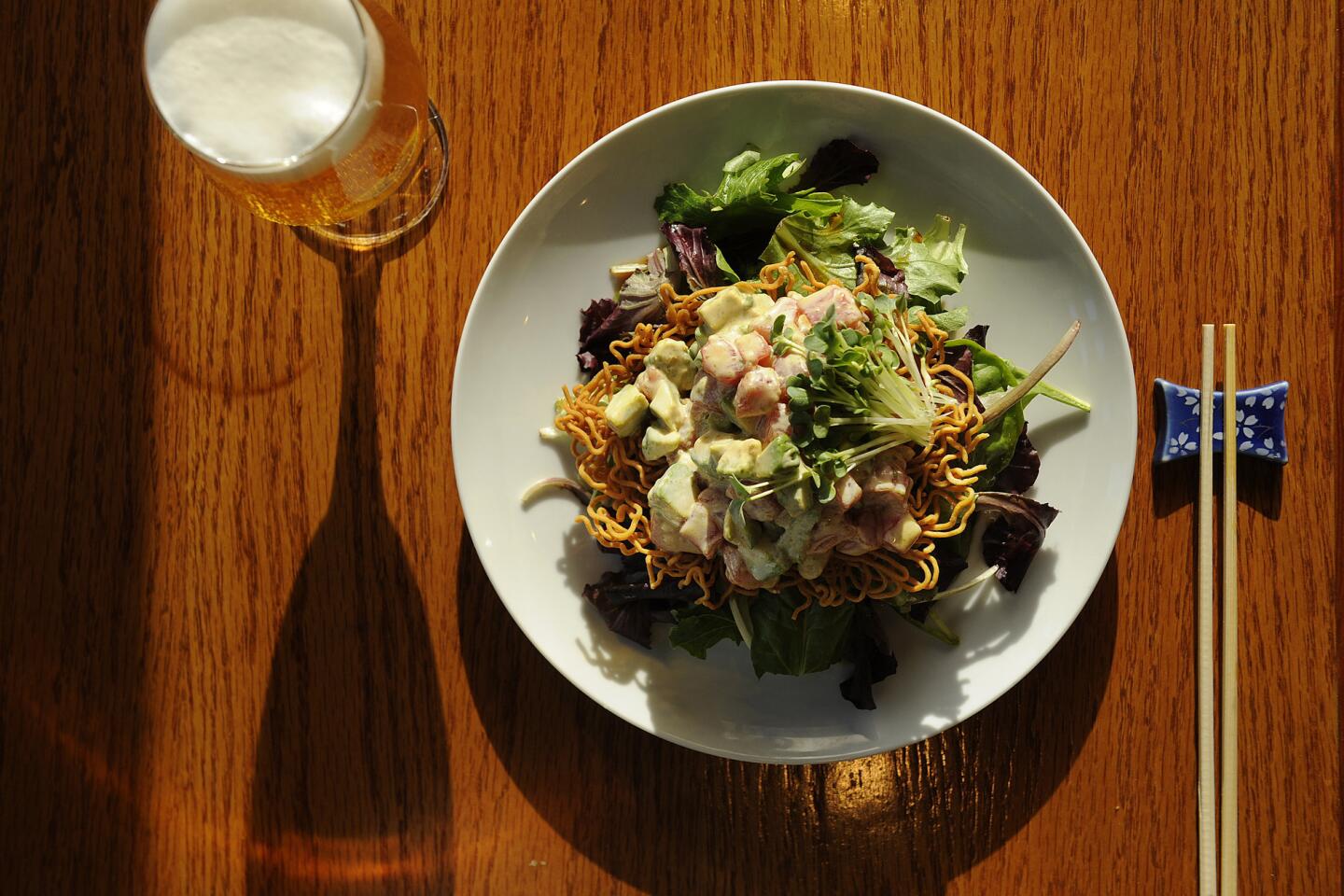Review: Kagura does a crisp business in the pork cutlet known as tonkatsu
Los Angeles, I believe, has yet to reach Peak Ramen. New sushi bars seem to open each week. In some parts of town, you are rarely more than a few minutes’ drive from a curry house, a Japanese spaghetti parlor or a plate of okonomiyaki. Yet occasionally it seems as if too little is said about tonkatsu, the crisply fried pork cutlet that can be one of the glories of the Japanese table, a dish that is often seen snuggling up to the rice at a curry house or as an unloved part of a food court combination meal but is rarely celebrated in its own right.
A fried pork cutlet — what could possibly taste better with a cold bottle of beer?
Tonkatsu is a recent enough entrant into the Japanese kitchen, a late-19th century imitation of Wiener schnitzel, it is said: floured, washed with beaten egg and rolled in the jagged bread crumbs called panko before it is fried, which creates a rugged, three-dimensional surface that sizzles to a deep, maximum crunch.
Tonkatsu is brilliant at showcasing particular breeds — Maisen, near the Omotosando district in Tokyo, offers several different varieties of pork, including one fed on spent tea leaves — and not even the most basic tonkatsu parlor would dare to serve commodity pork.
The best place to get Japanese tonkatsu in the Los Angeles area at the moment is probably Kagura, a dark, sprawling izakaya — food-oriented Japanese pub in Torrance. Half of the restaurant holds a warren of wooden booths, semi-enclosed for privacy, whose occupants at a certain hour seem to be equally made up of families with young children and groups of men contemplating the mysteries to be found in bottles of iced sake. Platters of sliced hamachi with wasabi relish, grilled mushroom salad and clams steamed with pasta litter the tables as if they were so many Tetris tiles.
If you were planning to explore izakaya culture in Southern California, you could do worse than to start at Kagura’s Torrance location, a minute or two south of the huge campuses of Honda and Toyota, at the confluence of an old commercial street and a remarkable stretch of Japanese strip malls. You may be able to find better ramen, udon, sushi and tempura elsewhere in the area, even elsewhere in the South Bay, but you won’t find a district that is more comfortably Japanese.
Hachi is where you go for beef tongue and intestine hot pots; Torihei has yakitori and oden; Beaux is good for fusiony pastas; Yuzu for seafood and duck; Nozomi for sushi and such; Irifune for elaborate set dinners — there are probably a dozen izakayas within a 15-minute walk, and on a weekend night you will find a line outside most of them.
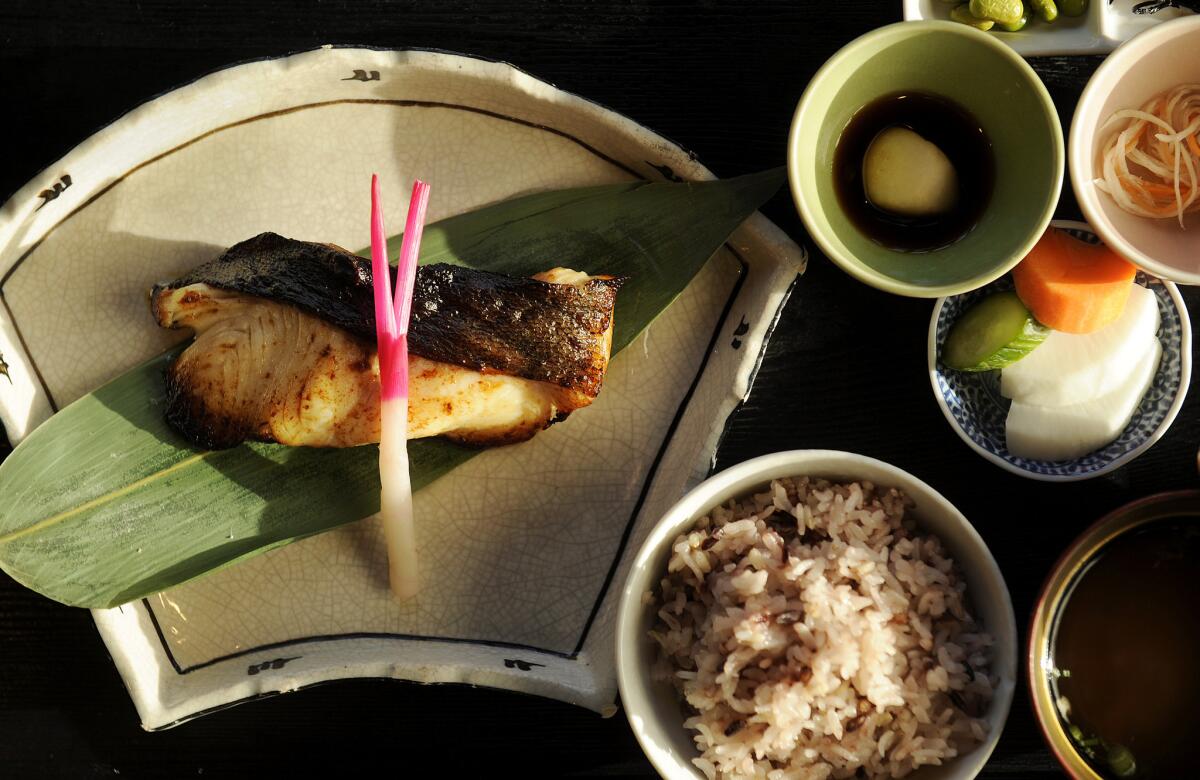
Gindara Saikyoyaki Gozen, a grilled black cod marinated in saikyo miso sauce, served with rice and miso soup at Kagura in Torrance.
Kagura, the tonkatsu-intensive branch of a small otherwise non-pork-focused chain, is a proper izakaya, at least as focused on drinking as it is on food — Echigo beer and Otokoyama sake go with almost everything — and as focused on enabling long conversations as it is on alcohol. You will probably go long minutes without seeing a waiter, and nobody is much interested in helping you decide between the fried eggplant with cod roe and the fried shishito peppers in a sticky sesame sauce. It is also a proper izakaya in that you had probably better be on time — I was once turned away when I arrived two minutes after its posted afternoon closing, and although it had been a long drive, I sort of respected the restaurant for that.
You will probably spend a bit of time trying to figure out whether the hockey puck-sized potato balls stuffed with molten cheese are worth it (they are), whether you should get the German sausages (nah), or whether they still have that dish of conger eel suimono you read about on a blog once (I’m guessing not).
You might consider an order of the spaghetti in a thick sea urchin cream sauce, which captures the nutty flavors of the shellfish without being too cloying. The kamameshi, slow-cooked rice with mushrooms, is worth the 40 minutes it takes — have it for a for a final course. The mochi agedashi, which pairs a gooey toasted rice cake with fried tofu in a thick sauce, is a miniature if fattening essay in texture.
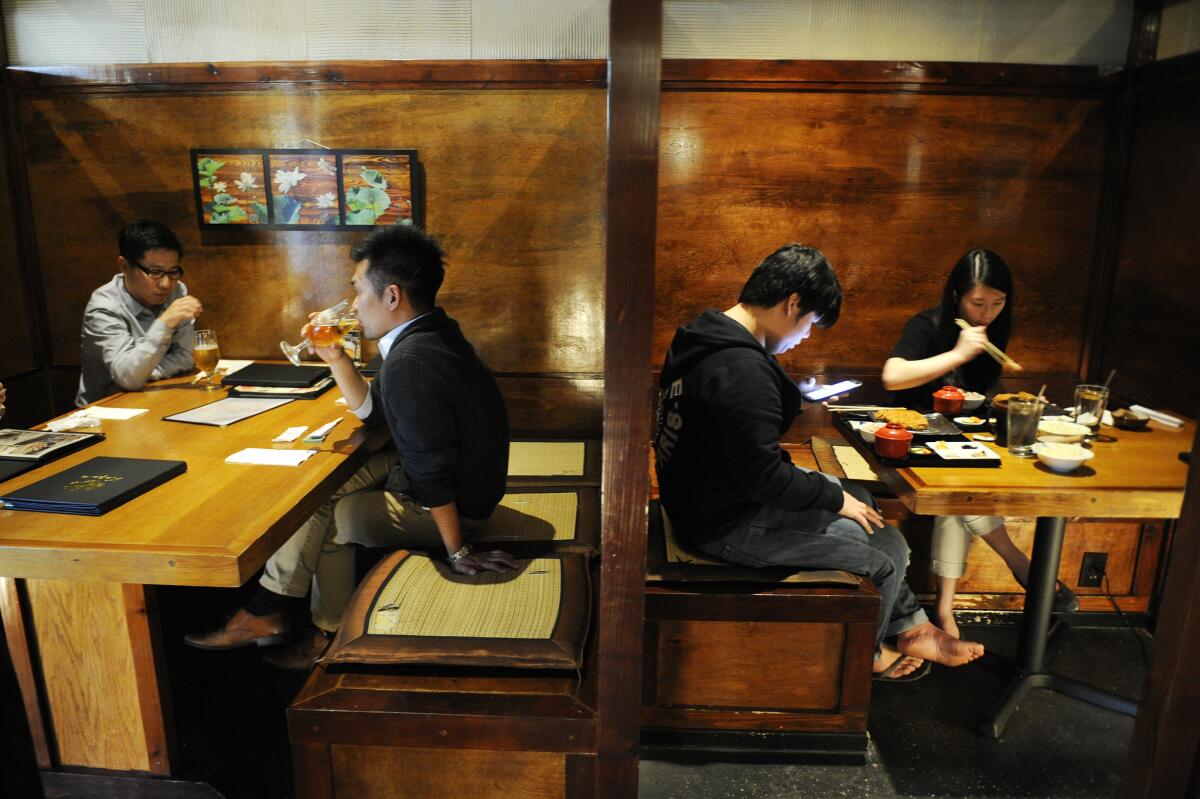
Diners in the wooden booths at Kagura.
But what the servers know better than you do is that you are going to end up with one of the gozen — set dinners, more or less — based around the fried pork. The miso-marinated black cod isn’t a bad choice, but the tonkatsu is why you’re here.
And the wooden gozen trays are happy things, set with pickles, small bowls of porky miso soup, an earthy five-grain brown rice concoction if you prefer it to white rice, a bowl of shredded cabbage dressed with tart soy, and a small mesh grid on which rests the golden slab of fried meat.
The well-marbled loin bursts with luscious fat when you bite into it; the filet is leaner and firmer, perhaps less interesting. Kagura’s specialty is the style known as mille-feuille — thinly sliced pork folded into a cutlet before it is breaded and fried, a soft, supremely juicy portion of meat. If you are that kind of person, you can even get your mille-feuille tonkatsu enhanced with oozing rivulets of cheese.
A ridged bowl holds a spoonful of freshly toasted sesame seeds and a small pestle — you grind the seeds until they release their fragrance and then mix in a few drops of the fruity, spicy tonkatsu sauce, poured from a rough clay pitcher, to make a dip for the pork. A smaller bowl is dabbed with wasabi-hot mustard. And then you’re set — dip, dab, crunch and repeat.
If you are still hungry afterward (you won’t be hungry afterward) consider the banana cutlet, slices of fruit battered and fried like the tonkatsu, served with chocolate sauce and a scoop of ice cream.
::
Kagura
In Torrance, an established Japanese restaurant specializes in tonkatsu.
LOCATION
1652 Cabrillo Ave., Torrance, (310) 787-0227, littletokyorestaurant.com.
PRICES
Lunch gozen $9.95-$19.50; dinner gozen $19.50-$28.95; small plates $4.50-$12.50.
DETAILS
Open daily, 11:30 a.m. to 1:30 p.m. and 5:30 p.m. to 10 p.m. Credit cards accepted. Beer, wine and sake. Lot parking just north of restaurant.
RECOMMENDED DISHES
Loin tonkatsu; mille-feuille tonkatsu; grilled black cod; cheese-stuffed potato croquette; fried banana cutlet.
MORE REVIEWS FROM JONATHAN GOLD
Shawn Pham’s Simbal is what you might call a Vietnamese izakaya
The small plates at Moruno hold some big ideas
Officine Brera is so grand and serious that it’s nearly operatic
More to Read
Eat your way across L.A.
Get our weekly Tasting Notes newsletter for reviews, news and more.
You may occasionally receive promotional content from the Los Angeles Times.
